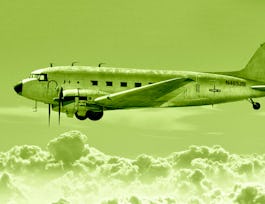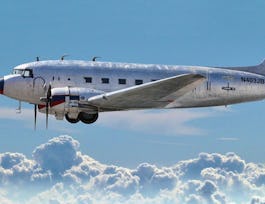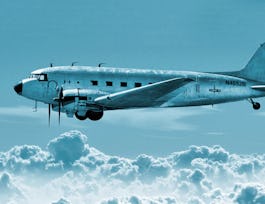In this course, you will understand the influence of the angle of attack and speed on the lift. Then we will focus on hazards and limitations, like stall, spiral dive, or flutter.


Flight mechanics - Lift and trajectory
This course is part of Fundamentals of Flight mechanics Specialization
Taught in English
Some content may not be translated

Instructor: Eric Poquillon
2,284 already enrolled
Included with 
Course
(39 reviews)
What you'll learn
Define the lift coefficent.
Describe the relation between angle of attack and speed.
Describe the limitation of a flight interms of speed, altitude and attitude.
Details to know

Add to your LinkedIn profile
14 quizzes
Course
(39 reviews)
See how employees at top companies are mastering in-demand skills

Build your subject-matter expertise
- Learn new concepts from industry experts
- Gain a foundational understanding of a subject or tool
- Develop job-relevant skills with hands-on projects
- Earn a shareable career certificate


Earn a career certificate
Add this credential to your LinkedIn profile, resume, or CV
Share it on social media and in your performance review

There are 4 modules in this course
At the end of this module, you will understand the influence of the angle of attack and speed on the lift.
What's included
2 videos6 readings3 quizzes1 discussion prompt1 plugin
Let's focus on hazards and limitations, like stall, spiral dive, or flutter... You will understand why stall phenomenon and Mach number limit the maximum lift and altitude the airplane can achieve. What is flutter and why the altitude and speed of the airplane must be restricted to a safe domain?
What's included
11 videos4 readings7 quizzes1 discussion prompt
As we know how to create lift, let's use it now to actually control the trajectory. We will first look at how to change our flight direction in the horizontal plane by doing a turn. We will then look at the change in the vertical plane when we pull up or push over. Sometimes, alteration of the trajectory is due to external factors like turbulence, which may result in unwanted load factor spikes. We will determine what we can do to reduce this nuisance.
What's included
6 videos3 readings3 quizzes1 discussion prompt
Test your knowledge.
What's included
1 reading1 quiz1 discussion prompt
Instructor

Offered by
Recommended if you're interested in Physics and Astronomy

ISAE-SUPAERO

ISAE-SUPAERO

ISAE-SUPAERO

National Taiwan University
Why people choose Coursera for their career




Learner reviews
Showing 3 of 39
39 reviews
- 5 stars
84.61%
- 4 stars
15.38%
- 3 stars
0%
- 2 stars
0%
- 1 star
0%

Open new doors with Coursera Plus
Unlimited access to 7,000+ world-class courses, hands-on projects, and job-ready certificate programs - all included in your subscription
Advance your career with an online degree
Earn a degree from world-class universities - 100% online
Join over 3,400 global companies that choose Coursera for Business
Upskill your employees to excel in the digital economy
Frequently asked questions
Access to lectures and assignments depends on your type of enrollment. If you take a course in audit mode, you will be able to see most course materials for free. To access graded assignments and to earn a Certificate, you will need to purchase the Certificate experience, during or after your audit. If you don't see the audit option:
The course may not offer an audit option. You can try a Free Trial instead, or apply for Financial Aid.
The course may offer 'Full Course, No Certificate' instead. This option lets you see all course materials, submit required assessments, and get a final grade. This also means that you will not be able to purchase a Certificate experience.
When you enroll in the course, you get access to all of the courses in the Specialization, and you earn a certificate when you complete the work. Your electronic Certificate will be added to your Accomplishments page - from there, you can print your Certificate or add it to your LinkedIn profile. If you only want to read and view the course content, you can audit the course for free.
If you subscribed, you get a 7-day free trial during which you can cancel at no penalty. After that, we don’t give refunds, but you can cancel your subscription at any time. See our full refund policy.

